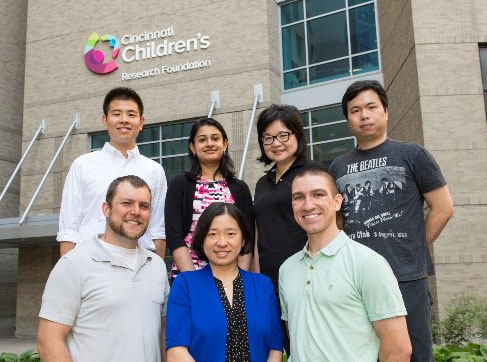Xu Lab Research
Research in the Xu laboratory is focused on development and application of cutting edge bioinformatics and systems biology approaches to reveal novel mechanisms controlling lung development and disease.
Current research in the lab is focused to two major areas, 1) the development of human/mouse LungMAP at both normal and disease conditions via multi-omics data analysis and knowledge integration, and 2) mechanistic understanding of Lymphangioleiomyomatosis cell origin, gene regulation and pathogenesis at single cell resolution.
- The lab is actively involved in the LungMAP consortium Cincinnati Children's Research center (Drs. Whitsett, Potter, Xu) and Data Coordinating Center (Drs. White, Aronow) in development of a detailed Lungmap via high-throughput single cell genomics, epigenomics and integration with other omics to provide useful tools and resources for the research community. Through the single cell transcriptome analysis of the mouse and human lung at different developmental stages, we identified major lung cell types/subpopulations, cell type specific gene signatures, and cell specific transcriptional regulatory networks and driving forces. We are currently working on the combined metadata generated in LungMAP and other external resources to understand the dynamic regulation of individual cell types during lung development and the deviation at different disease conditions. We developed multiple well received analytic and web tools for single cell RNA-seq analysis and interoperated data visualization, including “SINCERA”, “SLICE”, “SVIA”, “LungGENS”, “LGEA” “Gene at a glance”, “Cell at a glance” and “Region at a glance”, we actively expend data contents and develop new tools to meet the research needs.
- Lymphangioleiomyomatosis (LAM) is a destructive metastasizing neoplasm of the lung with unknown cell identity and cell origin. Our long term goal is to gain a deeper mechanistic understanding of hormonal signaling activating TSC-associated LAM pathogenesis and facilitate therapeutics research for LAM treatment. Working closely with Dr. McCormack and other members at the University of Cincinnati and Cincinnati Children's, we employed single cell RNA sequencing and single cell ATAC-seq on explanted LAM lungs and identified a unique LAMCORE cells population and associated signature genes and gene networks which were readily distinguished from those of endogenous lung cells. Our study strongly suggested uterus as the primary origin of pulmonary LAM cell. A number of novel LAM cell-specific proteins were identified that hold promise as potential biomarkers for diagnosis or prognosis and therapeutic targets. We are in the course to test the hypothesis that uterine transcription program (HOX family of TFs) orchestrate a network of genes to amplify steroid-dependent LAM pathogenesis and progression in the lung.







